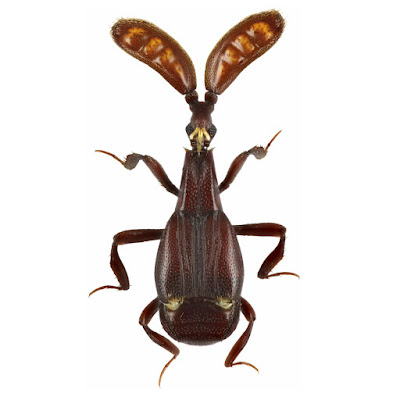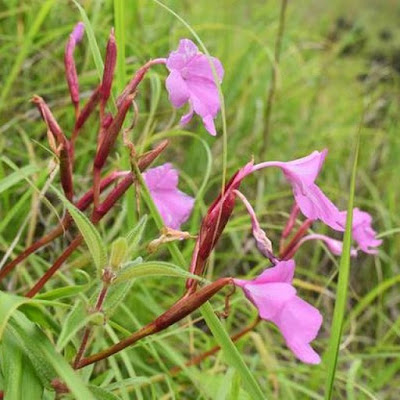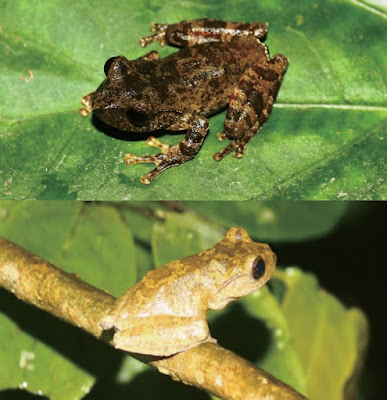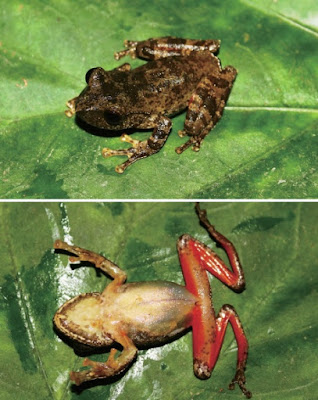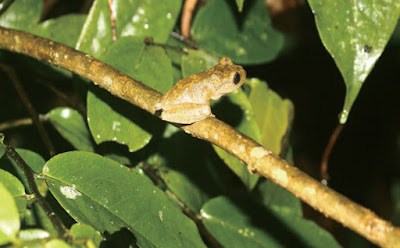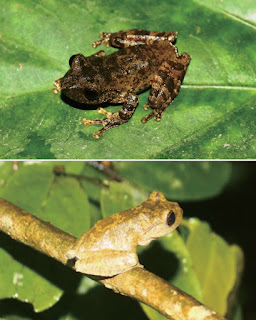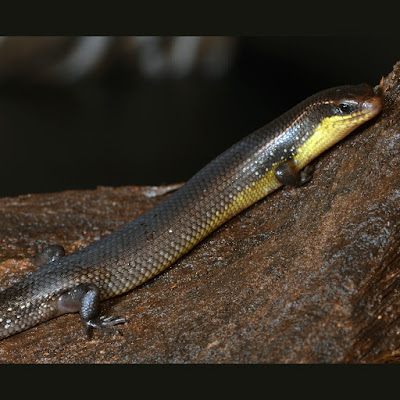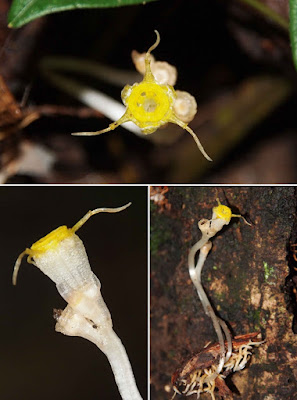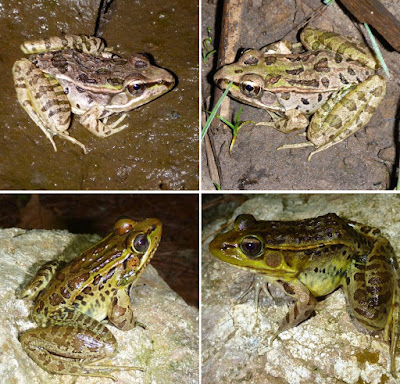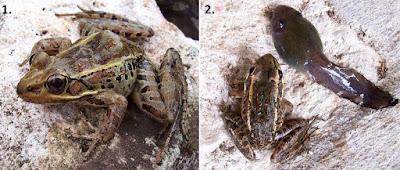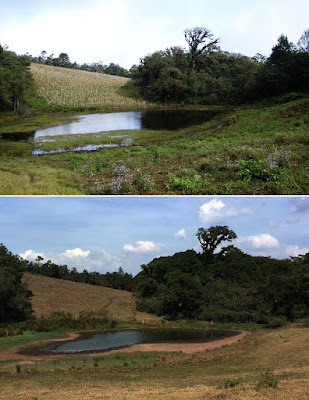[Most Recent Entries] [Calendar View]
Monday, January 15th, 2018
| Time | Event | ||||||
| 2:25a | [Entomology • 2018] Colilodion colongi • A New Species of the Genus Colilodion Besuchet, 1991 (Coleoptera: Staphylinidae: Pselaphinae) from Mindanao, the Philippines
Abstract Colilodion colongi sp. nov. of the clavigerite ant-loving beetle from Mindanao, the Philippines is described, illustrated, and distinguished from related species. The distribution map for all known species is given. Keywords: Coleoptera, Staphylinidae, Pselaphinae, Clavigeritae, Colilodionini, Colilodion, new species, Mindanao, the Philippines Peter Hlaváč, Dominik Vondráček and Alma B. Mohagan. 2018. A New Species of the Genus Colilodion Besuchet, 1991 (Coleoptera: Staphylinidae: Pselaphinae) from Mindanao, the Philippines. Zootaxa. 4370(5); 562-568. DOI: 10.11646/zootaxa.4370.5.7 | ||||||
| 4:25a | [Botany • 2017] Caulokaempferia dinabandhuensis • A New Species of Caulokaempferia (Zingiberaceae) from Manipur, India
A new species, Caulokaempferia dinabandhuensis Biseshwori & Bipin (Zingiberaceae) is described. This is the first report of the genus from Manipur, India. Caulokaempferia dinabandhuensis is characterized by tubular calyx widened in the middle and tapering towards the apex and suborbicular, deeply split labellum with elongated, obtuse tips. Full description and a photographic plate of this new species and comparative analysis among three Caulokaempferia are presented. Key words: Caulokaempferia dinabandhuensis, India, Manipur, new species, Shirui Hill. Biseshwori Thongam and Bipin Konsam. 2017. A New Species of Caulokaempferia (Zingiberaceae) from Manipur, India. The Journal of Japanese Botany. 92(2); 82–86. Two new Ginger species found in the northeast thehindu.com/sci-tech/energy-and-environ | ||||||
| 4:50a | [Herpetology • 2017] Rhacophorus hoabinhensis • A New Species of Rhacophorus (Anura: Rhacophoridae) from northern Vietnam
Abstract We describe a new species of Rhacophorus based on two adult specimens collected from Hoa Binh Province, northern Vietnam. Rhacophorus hoabinhensis sp. nov. is distinguishable from its congeners on the basis of a combination of the following morphological characters: size small (SVL 31.1–32.5 mm in males); head slightly longer than wide; vomerine teeth absent; snout short (SNL/SVL 0.16); dorsal skin smooth; forearm and tarsus with dermal fringes; dermal appendage at vent present; webbing formula on fingers I12/3-12/3II1-2III1-1IV and on toes I3/4-1II1/2- 1III1/2-1IV1-1/2V; dorsal surface grey yellow with brown spots; lower jaw region dark grey, throat, chest and belly cream; anterior and posterior thighs, as well as ventral surface of tibia orange. The interspecific uncorrected genetic distances (16S rRNA gene) between the new species from Hoa Binh and other analyzed congeners varied from 9.8% to 17.4%. In the phylogenetic analyses, the new species revealed to be a representative of Rhacophorus and was nested within the R. hoanglienensis-orlovi species group. Keywords: Rhacophorus hoabinhensis sp. nov., karst forest, molecular phylogeny, taxonomy, Hoa Binh Province
Rhacophorus hoabinhensis sp. nov. Etymology: The specific epithet “hoabinhensis” refers to the type locality of the new species, Hoa Binh Province. For the common names we suggest Hoa Binh Treefrog(English), and Ếch cây hòa bình (Vietnamese). Distribution: R. hoabinhensis is currently is known only from the type locality in Hang Kia–Pa Co Nature Reserve, Hoa Binh Province, Vietnam. Natural history: Rhacophorus hoabinhensis appears to be closely associated with karstic environment. Specimens were found at night between 19:00 and 23:30h, near a small pond. The surrounding habitat was secondary karst forest, consisting of medium and small hardwoods mixed with shrubs and vines. Specimens were found on leaves and branches of trees, about 1.2–1.5 m above the ground. The advertisement call of the species was not heard. The air temperatures at the times of collection ranged from 14.8 to 18.9o C and relative humidity from 84% to 93%. Other rhacophorid species recorded in Hang Kia–Pa Co Nature Reserve were Raorchestes parvulus Boulenger, R. feae Boulenger, R. kio Ohler and Delorme, R. orloviZiegler and Köhler, Theloderma albopunctatum Liu and Hu, T. gordoni Taylor, and T. lateriticum Bain, Nguyen and Doan. Females and the tadpole of Rhacophorus hoabinhensis have not been recorded so far. Tao Thien Nguyen, Cuong The Pham, Truong Quang Nguyen, Hoa Thi Ninh and Thomas Ziegler. 2017. A New Species of Rhacophorus (Amphibia: Anura: Rhacophoridae) from Vietnam. Asian Herpetological Research. 8(4); 221–234. DOI: 10.16373/j.cnki.ahr.170046 Ếch cây hoà bình – Rhacophorus hoabinhensis | ||||||
| 4:58a | [Herpetology • 2018] Lygosoma samajaya • Unrealized Diversity in An Urban Rainforest: A New Species of Lygosoma (Squamata: Scincidae) from western Sarawak, Malaysia (Borneo)
Abstract We collected two specimens of an undescribed species of Lygosoma from pitfall traps in an urban rainforest in Kuching and from the base of a forested hill in western Sarawak, East Malaysia. The new species is diagnosable from all south-east Asian congeners by morphological characters, and most closely resembles Lygosoma herberti from the Thai-Malay Peninsula. The new species shows substantial molecular divergence from its closest relatives in two protein-coding genes, one mitochondrial (ND1) and one nuclear (R35) that we sequenced for several south-east Asian congeners. We describe the new species on the basis of this distinct morphology and genetic divergence. It is the third species of Lygosoma known from Borneo, and highlights the continuing rise in lizard species diversity on the island. In addition, the discovery of this species from a small urban rainforest underscores the importance of preserving intact rainforest areas of any size in maintaining species diversity. Keywords: Reptilia, Borneo; Sarawak; Scincidae; Lygosoma samajaya new species
Lygosoma samajaya sp. nov. Etymology. The species epithet samajaya is a proper noun in apposition that refers to the locality of collection of the holotype at the Sama Jaya Forest Reserve in Kuching, Sarawak, Malaysia. This name draws attention to the importance of small urban rainforest parks in sustaining species diversity. Benjamin R. Karin, Elyse S. Freitas, Samuel Shonleben, L. Lee Grismer, Aaron M. Bauer and Indraneil Das. 2018. Unrealized Diversity in An Urban Rainforest: A New Species of Lygosoma (Squamata: Scincidae) from western Sarawak, Malaysia (Borneo). Zootaxa. 4370(4); 345–362. DOI: 10.11646/zootaxa.4370.4.2 | ||||||
| 2:33p | [Botany • 2018] Thismia bokorensis • A New Species (Burmanniaceae) representing A New Generic Record for Cambodia [Flora of Bokor National Park VII]
The genus Thismia Griffith (1844: 221) of the tribe Thismieae, Burmanniaceae sensu APG IV (2016) or Thismiaceae of other authors, represents one of the most species-rich mycoheterotrophic genera and consists of more than 60 species (Jonker 1948, Merckx 2008). Considering that the majority of these species were collected only once (Jonker 1948), and that many new species have recently been discovered, especially from various Southeast Asian countries (e.g., Tsukaya & Okada 2012, Dančák et al. 2013, Nuraliev et al. 2014, 2015, Truong et al. 2014, Chantanaorrapint & Sridith 2015, Li & Bi 2013, Hroneš et al. 2015, Tsukaya et al. 2017, Suetsugu et al. 2017), many more undescribed species are probably still hidden in the tropical rain forests of Southeast Asia. Here, we describe a new species, Thismia bokorensis Suetsugu & Tsukaya, discovered during a botanical survey in Bokor National Park, Cambodia, in 2013. This is the first record of the genus Thismia for Cambodia. The newly discovered specimen apparently belongs to the section Thismia (formerly Euthismia Schltr.) subsect. Brunonithismia Jonker (1938: 242), in having free and spreading inner perianths, larger inner perianth lobes, and vermiform, creeping roots. After a careful examination, the unknown plant was found to have a significantly different floral morphology from all the other known species.
Thismia bokorensis Suetsugu & Tsukaya, sp. nov. Type:— CAMBODIA. Kampot Province: Bokor National Park, evergreen forest near a stream, ... elev. 370 m, 10 Aug. 2013, Tagane, Fuse, Yokota, Zhang & Chhang 5857 (holotype: TNS, in the spirit collection). Thismia bokorensis is similar to Thismia tentaculata Larsen & Averyanov (2007: 16) of Vietnam and Hong Kong in having the lateral appendage of the connective that does not exceed the apical part of the connective, three-toothed apical margin of the connective, and the shorter light yellow tentacles in inner perianth lobes. Habitat and ecology:— Only one individual was found in the evergreen forest, near a stream, at an elevation of 370 m. The forest was dominated by Scaphium affine (Malvaceae), Diospyros schmidtii (Ebenaceae), Ardisia sanguinolenta (Primulaceae), Epiprinus siletianus (Euphorbiaceae), Mallotus subpeltatus (Euphorbiaceae), Knema lenta (Myristaceae), Syzygium siamense (Myrtaceae), and Prismatomeris tetrandra (Rubiaceae). The roots of the specimen above were tangled to an old seed of Ixonanthus reticulata (Ixonanthaceae). The flowering specimen was collected in August. Kenji Suetsugu, Hirokazu Tsukaya, Shuichiro Tagane, Phourin Chhang, Tomohisa Yukawa and Tetsukazu Yahara. 2018. Flora of Bokor National Park VII: Thismia bokorensis (Burmanniaceae), A New Species Representing A New Generic Record. Phytotaxa. 334(1); 65–69. DOI: 10.11646/phytotaxa.334.1.10 | ||||||
| 3:33p | [Herpetology • 2018] Rana lenca • An Integrative Assessment of the Taxonomic Status of Putative Hybrid Leopard Frogs (Anura: Ranidae) from the Chortís Highlands of Central America, with Description of A New Species
Integrative taxonomy seeks to approach the complex topic of species diagnosis using independent, complementary lines of evidence. Despite their ubiquity throughout North and Central America, taxonomy of the American leopard frogs (Anura: Ranidae: Rana: subgenus Pantherana) remains largely unresolved, and this is arguably nowhere truer than in the Central American country of Honduras, where there are two nominal species, the taxonomy of which remains unresolved. Leopard frogs from several mountainous areas along the continental divide in Honduras have previously been considered putative hybrids between Rana brownorum and R. cf. forreri, as opposed to two alternate hypotheses: one that they represent a high-altitude eco-morph of a single widespread species that included both lowland forms, or a second that there is an undescribed highland species distinct from either of the recognized lowland forms. We examine this set of hypotheses using three independent lines of evidence. First, we used species distribution modelling to examine potential geographic isolation of the highland form and the two putative parental lowland species, and found strong ecological separation between the highland and lowland forms. Second, mitochondrial and nuclear DNA supports the distinction of the highland form from both putative parental species, with mtDNA data refuting the hypothesis that representatives of either species may represent a matrilineal founder. Morphologically, the highland form is significantly smaller than, and otherwise readily differentiated from, both R. brownorum and R. cf. forreri, as well as all other Rana found in Honduras and adjacent areas. As a result, we formally describe the highland leopard frog as a new species. Key words: Amphibia, integrative taxonomy, mitochondrial DNA, Pantherana, phylogeny, rhodopsin, species distribution modelling Rana lenca sp. nov. Common English name. Lenca Leopard Frog Common Spanish name. La Rana Lenca Etymology. The name lenca is given in honour of the indigenous Lenca people, the traditional inhabitants of the mountainous region of south-western Honduras.
Ileana Luque-Montes, James D. Austin, Kayla D. Weinfurther, Larry David Wilson, Erich P. Hofmann and Josiah H. Townsend. 2018. An Integrative Assessment of the Taxonomic Status of Putative Hybrid Leopard Frogs (Anura: Ranidae) from the Chortís Highlands of Central America, with Description of A New Species. Systematics and Biodiversity. In Press. DOI 10.1080/14772000.2017.1415232 |
| << Previous Day |
2018/01/15 [Calendar] |
Next Day >> |
